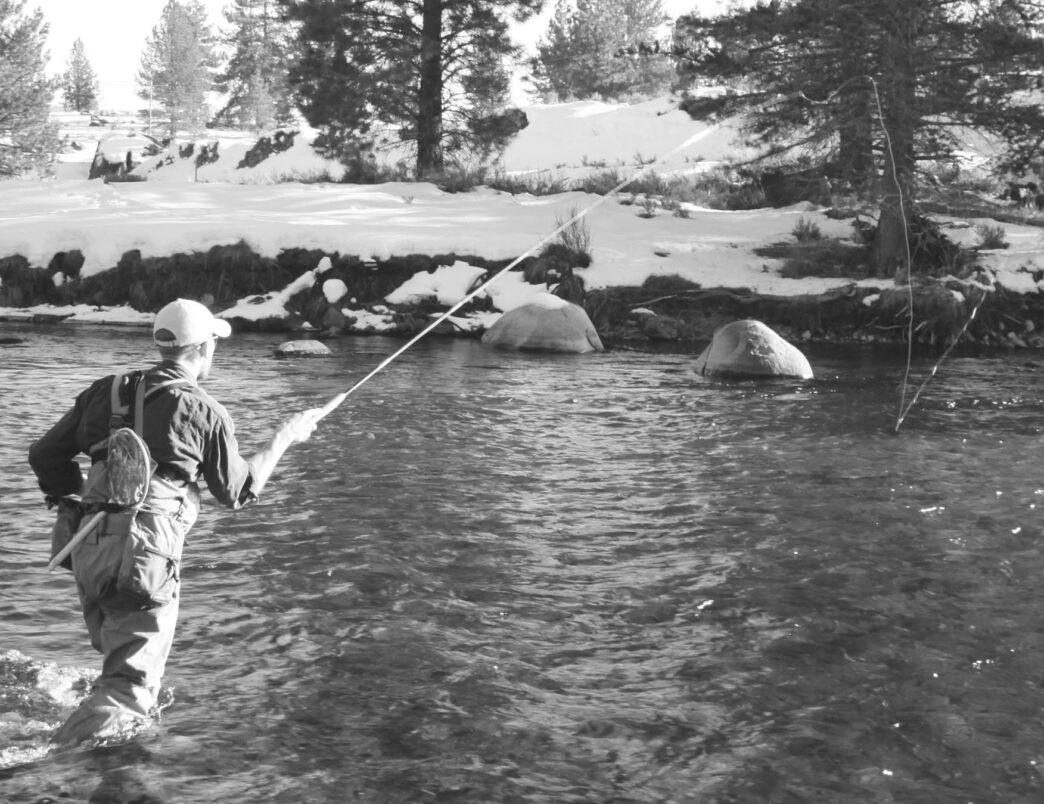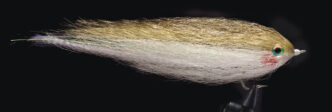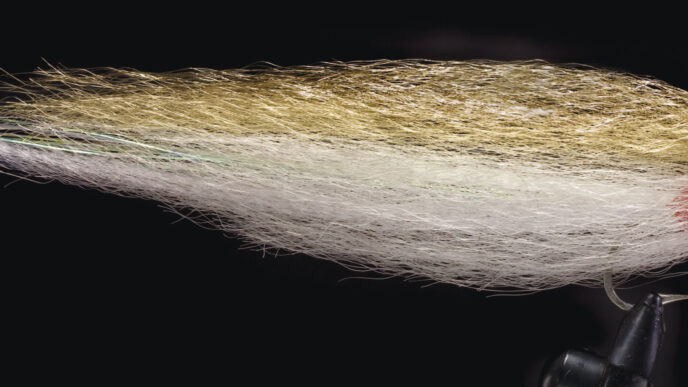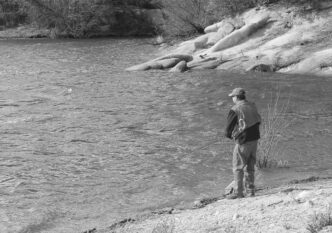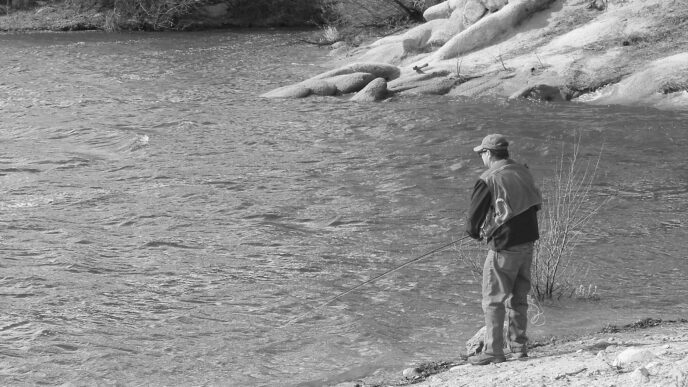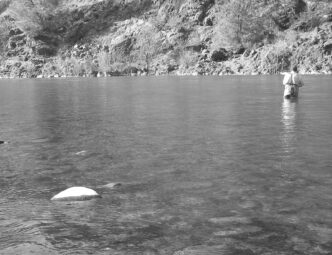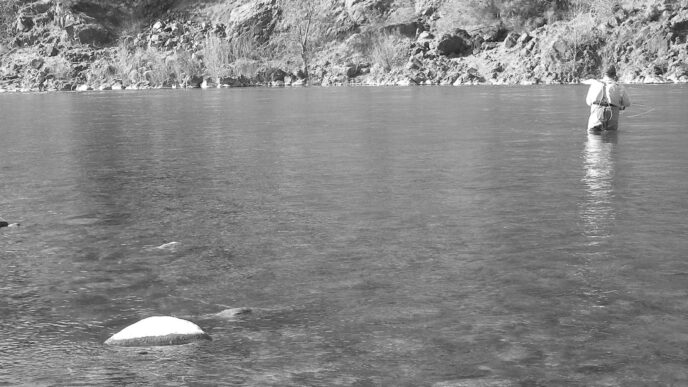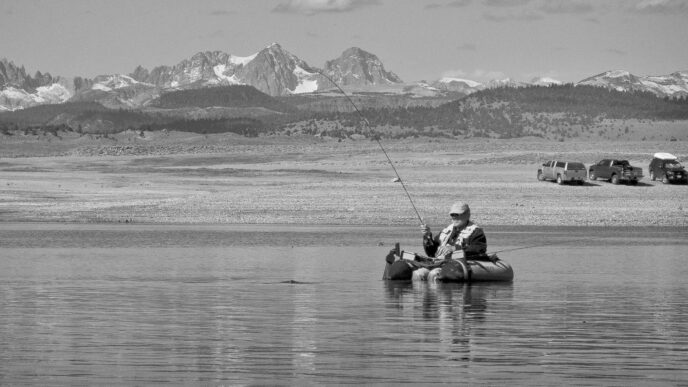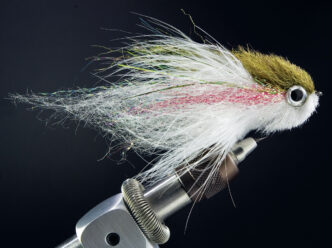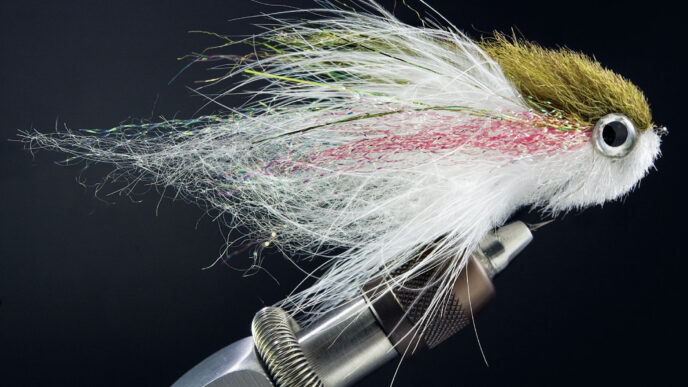I had been hearing about tenkara (pronounced ten kah da) for the past couple of years, since Daniel Galhardo opened up shop with Tenkara U.S.A. in San Francisco, but I figured it was no more than a Hail Mary attempt at exploiting an unpopulated product category within the withering fly-fishing market. Nice try, but I wasn’t going to bite. Fish with a string tied to a stick? I’d rather sling a handline coiled around a beer bottle. At least I could drink the beer. From my naïve perspective, tenkara seemed to be just the so-called “art” of poke polling with a willow branch or dapping with a bamboo pole. Child’s play.
Well, give a bucket, hatchet, knife, or a fishing pole to any child from any culture and the kid will know how to use it. A hook on a string on a stick is as perfect and universal a tool as anything on the planet: no moving parts, and it can feed communities for generations.
Add a fly reel and some weighted line to that elegant tool, and you’ve suddenly mucked things up. Give a fly-fishing rig to an inner-city kid, and he’ll look at it inquisitively, then use the reel to open a beer bottle. Give it to a Dayak from Borneo, and he’ll employ all the pretty string to tie something up, then set the reel aside for future consideration. I know he will, because I’ve seen it firsthand. Then the stars started aligning. First, Phil Takatsuno sent me some rough cuts of a video he was producing with Craig Mathews of Blue Ribbon Flies about tenkara fishing the Madison in midwinter. In the video, Craig dutifully assembles his rod (in all of 20 seconds) and starts lobbing casts into fishy-looking pockets. It is a blooper-style video, with Craig slipping and skating across a 10-foot ice shelf to access the river, where he immediately gets clobbered by doghouse-sized icebergs. In the clips, Craig’s profanities are swept away by gale-force winds while Phil shouts out warnings of yet another iceberg on the way. Craig dutifully high sticks a pair of weighted nymphs and quickly hooks and lands a beautiful 17-inch rainbow. A few minutes later, he hooks and lands another. Waving a string on a stick on a blustery winter day in a berg-filled river may not be the best way to initiate a fad, but it was certainly fun to watch and an obviously effective way to catch fish.
A few days later, I was on the phone with Randall Kaufmann, planning a highSierra pack trip, when he started telling me how Yvon Chouinard is cleaning out the Snake River with a tenkara rod and that the system has become Chouinard’s go-to backpacking rig. Later that week, Yvon himself rolled into town, and for the next three days, I was peppered with tenkara this and tenkara that. It was an unrehearsed full-court tenkara press from some of the best anglers on the planet. I caved and ordered a rod from Daniel Galhardo.
The rod arrived the very next day, shipped first class and expertly wrapped in Daniel’s Subaru. Daniel himself was a joy. I expected some wise old Japanese guy with a wispy mustache, but instead met a wise young guy with a wry smile and a soft Brazilian accent. Daniel wasted no time and deployed the first tenkara rod I had ever handled. It consisted of a graphite tube that had been chopped into interlocking sections with a long cork grip on one end and a thin red string dangling off the other. It looked like a 13-foot sex toy. He told me the string is called a lilian, which only confirmed my suspicions. The lilian has a knot at the end that acts as a stopper when you girth hitch or slip knot your fishing line to the string.
The line was wrapped around a special puck that looked like a plastic Maxima leader spool with a big hole bored through the middle and the Maxima label peeled off. When the major manufacturers pick this up, it will be machined from solid aluminum bar stock and touted as a large-arbor tenkara spool. Conveniently enough, the faux Maxima spool slides easily down the graphite pole and perfectly mates with the cork grip. Once I had been shown the lilian, tenkara’s subtle eroticism didn’t elude me.
The few videos and descriptions of tenkara I had seen prepared me for a lesson in dapping and high sticking. However, when Daniel made a crisp, tightly looped cast and hit a fist-sized pocket 30 feet away, I was incredulous. His line, nothing more than 18 or 20 feet of 16-pound fluorocarbon leader tied to a few feet of 5X tippet, was effortlessly lifted from the water by his 13-foot rod. Only the fly and a few inches of tippet remained touching the film. It was a perfect drag-free presentation . . . more perfect than any Western fly rod could ever approach in that situation. This old dog had been taught a new (but really old) trick, and I was sold.
Dapping and high sticking were part of the drill, but with a lot more control and finesse than I could have imagined. The entire 13-foot rod weighs a mere three ounces, so high-sticked, long-line control is effortless. Even my 7-foot 3-weight feels like a slug by comparison. The classic tenkara drift is with a slightly drowned fly resembling a soft hackle (the hackles are pushed forward over the eye, rather than draped over the body of the fly), presented in the first few inches under the film. The line is nearly taut with the fly (when properly fished, the rod tip has a slight bend), and the fly is continually raised up and released to sink in a pulsing, squid-like motion. This not only provides tantalizing action, but also sets the hook, should some unseen fish mouth the bug.
Another classic tenkara presentation is to cast repeatedly to the side and just out of range of the prospective trout. When the fish has become thoroughly aroused, only then does the angler drift the fly right over it. George La Branche would have approved of this create-a-hatch technique.
Daniel headed for home and left Lisa and me with a couple of rods to play with. An hour later, we were on Deer Creek, ready to slay a slew of fish with tenkara.
Almost immediately, everything went wrong. We rigged up on the beach and instantly, both of us were in trouble. Thirteen-foot fishing rods and 20 feet of loose monofilament have a strong affinity for blackberries, willows, and alders. We couldn’t move without getting stuck. It took nearly half an hour for us to realize the obvious: we weren’t using Western-style fly rods, and in only a few seconds, we could collapse the 13-foot poles down to 18-inch batons and wade right through the brush with impunity. Once back in the water, with a flick of the wrist, the entire system was once again deployed, and we were fishing. Pretty soon we were collapsing and expanding our rods without a second thought and rapidly covering a small, brushy creek that would have normally been too much of a pain to bother with. At the end of the trip, we coiled the line around the leader pucks, slid them onto the cork handles, and went home.
The next day, we fished the South Fork of the Yuba at Jones Bar. In a matter of seconds, the rods were extended and we were fishing, but in a matter of a hours, we still hadn’t seen an insect, much less a trout, so we headed downstream.
The mainstem Yuba near Highway 20 was out of control. Tenkara has its limits, and there is no reason why a sane human would approach a 3,000-cubic-foot-per-second river without a reel. So that’s what we did. As the Joni Mitchell song goes, “You don’t know what you’ve got ’til it’s gone.” I immediately knew what was gone when we started fishing the big water. Reels have been part and parcel of fly fishing for a long time, and I simply took them for granted. Tenkara made me realize what a marvelous invention the reel is. Never again will I say that a reel is “just” a place to store line. In big water, chasing big fish, a reel is just as important as the rod and line. The Galvans need not fear tenkara. The North Fork of the Yuba near Sierra City is tenkara paradise, though. There, we effortlessly flicked flies deep under overhanging alders and picked pockets like Fagin. With so much line held off the water, we easily could keep the fly swimming in small eddies and drifting through turbulent water without drag for a dozen or more feet. I can’t imagine ever approaching a small stream with conventional fly gear again. If this sounds like a testimonial or product endorsement, it is. It is unsolicited and not paid for (though we haven’t given Daniel his rods back yet). Tenkara is legit: a stick, a string, and a hook with some feathers tied to it. No reel to confound the issue. It embodies hundreds of years of tradition unencumbered by centuries of progress. It is fly fishing stripped to its basic components, and in this increasingly complex world, it is nice to experience and enjoy something a child would understand.




